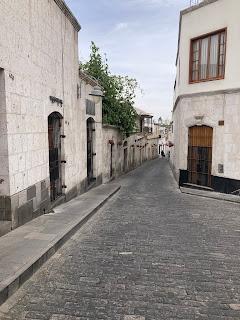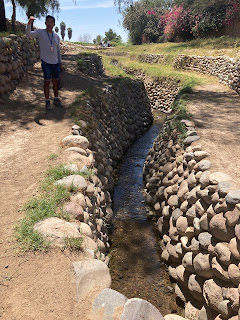November 16th-18th
I took my first Peruvian night bus from Nazca to Arequipa, the second largest city
in Peru with a little over a million inhabitants. One theory behind the origin of its name is
from the word Ari meaning “summit” and Queppa which is “behind” so it’s the
city located behind summits. This makes
sense as there are 3 volcanoes around the city: Misti which last erupted in 1985,
dormant Chacani and extinct
Pichu Pichu. Arequipa is known as the “White City” since a
lot of its historic buildings are built with white volcanic rock known as
Sillar.
On the overnight bus:
My first view of the main square:
Being at an altitude of 2335 meters above sea level, I decided
to take it relatively easy the first day to acclimatize as Nazca only sits at
520 meters. I met up with the Dutch
couple, Reinier and Sibel, for drinks and dinner in the main square, also known
as Plaza de Armas. Pretty much all
Peruvian cities have a square with this name, a hangover from the Spaniards I
would guess.
Misti Volcano:
Reinier was brave and tried the Peruvian delicacy cuy for the first time. If you’re not familiar with cuy, well it is guinea pig. Yup, guinea pig…those cuddly little pets that many kids love as pets in many Western countries. We all agreed that the dish would have been more appealing if it didn’t still have its little legs and head sporting its small front teeth. Reinier did offer me a bite which I decided I had to try. It was alright, a bit greasy but I think part of that was that it wasn’t the best restaurant. When in Rome!
The following day I booked a walking tour which started at 10 am. First, I charged up with an awesome breakfast at a place called Eco Brunch, which was recommended to me by Reinier and Sibel, and it did not disappoint…super yummy.
The meeting point was on a pedestrian-only street a few blocks from the Plaza de Armas. We started off with only 6 tourists, but we were soon joined by 8-10 more people once we reached a small park called the Plaza de San Francisco. We walked along some narrow streets with the guide explaining some of the history of the city.
Starting the tour:
Next, we ventured into Mundo Alpaca - Alpaca World! We walked by the shops at the front of the
complex filled with a variety of clothing from sweaters to scarves made from
alpaca or llama fur, lots of nice looking stuff. Back outside there was a pen with both
alpacas and llamas hanging out. We
learned that and an easy way to tell the two animals apart is by looking at the
neck. Llamas have longer necks than
alpacas.
An alpaca:
A llama:The sorting of the fur must be done manually:
We spent a good chunk of the tour in Alpaca World, a bit too
much to my liking. Sure, we learned a
lot about these animals but wasn’t this supposed to be a walking city
tour? Getting back on track, we wandered
our way towards the centre of the city.
One interesting tidbit that the guide mentioned was that important historical
buildings sport a blue and white little shield mounted on the wall and there’s
a QR code near the door. You can quickly
scan the door and find out interesting information about the structure. Great idea.
The tour finished on the same rooftop that I had visited the
previous evening with Reinier and Sibel.
The group joined in a toast with some little drink and then we parted
ways. Overall, I think the tour could
have been better but it was alright.
Another beautiful sunset in Arequipa:



























































